
The foot and ankle is a complex joint involved in movement and providing stability and balance to the body. The foot and ankle consist of 26 bones, 33 joints, and many muscles, tendons and ligaments.

The foot and ankle is a complex joint involved in movement and providing stability and balance to the body. The foot and ankle consist of 26 bones, 33 joints, and many muscles, tendons and ligaments.
Initial assessment and diagnosis Early review and an expedient management care strategy Option for on referral as needed
Physiotherapy management regime Targeted shoulder rehabilitation Hydrotherapy and exercises
T: (08) 8232 5566 E: [email protected]
Where surgical assessment and care may be required or where conservative management has failed to achieve a satisfactory outcome.
T: (08) 8236 4100 E: [email protected]

Coming soon
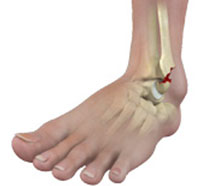
The ankle joint is composed of three bones: the tibia, fibula, and talus which are articulated together. The ends of the fibula and tibia (lower leg bones) form the inner and outer malleolus, which are the bony protrusions of the ankle joint that you can feel and see on either side of the ankle.
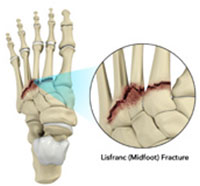
The tarsometatarsal joint refers to the region found in the middle of the foot. It is also called the Lisfranc joint. It is the junction between the tarsal bones (a group of seven articulating bones in the foot) and metatarsal bones (a group of five long bones in the foot).

A sprain is the stretching or tearing of ligaments, which connect adjacent bones and provide stability to a joint. An ankle sprain is a common injury that occurs when you suddenly fall or twist the joint or when you land your foot in an awkward position after a jump. Most commonly it occurs when you participate in sports or when you jump or run on a surface that is irregular.
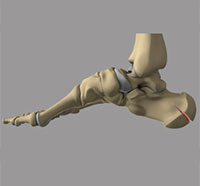
The calcaneus or heel bone is a large bone found on the rear part of the foot. The calcaneus connects with the talus and cuboid bones to form the subtalar joint of the foot. A fracture is a break in a bone from trauma or various disease conditions.

A stress fracture is a small crack in the bone which occurs from an overuse injury. It commonly develops in the weight-bearing bones of the lower leg and foot. When the muscles of the foot is overworked or stressed, they are unable to absorb the stress and transfer it onto the bone, which cracks under the pressure.
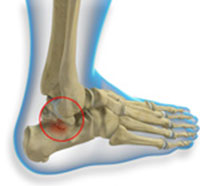
The talus is a small bone at the ankle joint that connects the heel bone and the shin bones, enabling the up and down movement of the foot. Fractures in the talus bone may occur due to a fall from great heights, motor vehicle accidents or sports injuries. Symptoms include severe ankle pain, inability to walk, swelling and tenderness.

The forefoot is the front of the foot that includes the toes. Fractures occurring in this part of the foot are painful, but very often not disabling. There are 2 types of fractures namely, traumatic fracture and stress fracture. Traumatic fractures occur when there is a direct impact of your foot on a hard surface.
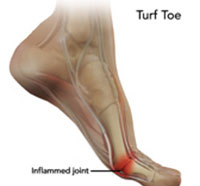
Turf toe is an injury to the ligament at the base of the big toe. It is a painful condition which usually results from jamming of the toe into the ground or excessive backward bending of the toe. As it is more common in athletes playing on artificial turf, especially those involved in field sports such as football, baseball and soccer, it is known as turf toe.

The Achilles tendon is one of the longest tendons in your body which stretches from the heel bone to your calf muscles. It appears as a band of tissue at the back of your ankle and above your heel. The Achilles tendon attaches to the heel bone over a broad area.
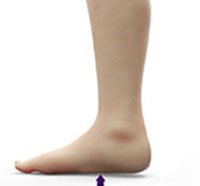
Flatfoot, also known as "fallen arches" or pes planus, is a deformity in which the arch of the foot that runs lengthwise along the sole has collapsed to the ground or not formed at all. Flatfoot is normal in the first few years of life as the arch of the foot usually develops between the age of 3 and 5 years.
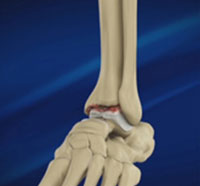
Arthritis is inflammation resulting from the degeneration of cartilage in the joint causing pain, swelling, and stiffness in the joints resulting in restricted movements. Arthritis of the foot and ankle joint can occur due to fracture, dislocation, inflammatory disease, or congenital deformity.

A bunion is a bony protuberance that appears on the external surface of the big toe when it angles toward the adjacent toe. It is an extra bone and a fluid-filled sac that grows at the base of the big toe.

Coming soon
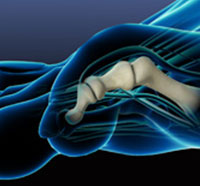
Claw toe is a deformity, where a toe bends and appears like a bird's claw. The affected toe is bent upward from the joint at the ball of the foot and downward at the joints in the middle and tip of the toe to curl under the foot. Hard thick skin called corns may develop under the ball of the foot or on the top of the affected toe, causing pain while walking.
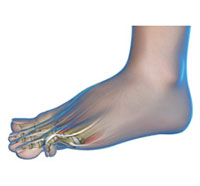
A hammertoe is a deformity of a lesser toe (second through fifth toes), where the toe gets bent upward at the toe's middle joint, resembling a hammer. The bent portion may rub against a shoe causing pain, irritation and development of corns.
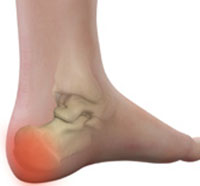
The heel is made up of the calcaneus bone and supported by a network of muscles, tendons, ligaments and soft tissues, which together support the weight of the body and stress during movement. Heel pain is a common symptom of excessive strain placed on these structures.
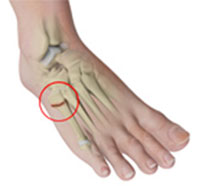
Coming soon
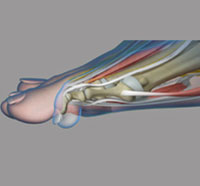
Anatomically the foot is divided into the forefoot, midfoot and hind foot. The Forefoot has 4 small toes called phalanges and 1 large toe called the hallux or big toe. Phalanges have 3 bones and 3 joints, while the big toe has 2 bones and 2 joints.
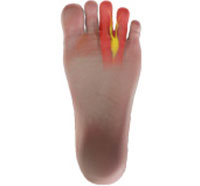
Morton's neuroma refers to a nerve injury between the toes, usually the third and fourth toes, which causes pain and thickening of the nerve tissue. Compression or chronic irritation of this interdigital nerve is the main cause of Morton's Neuroma.

Plantar fasciitis refers to inflammation of the plantar fascia, a thick band of tissue that lies at the bottom of the foot. It runs from the heel bone to the toe and forms the arch of your foot. Plantar fasciitis is one of the most common causes of heel pain.
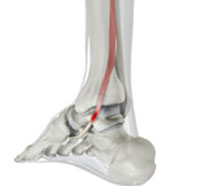
The posterior tibial tendon passes through the ankle to attach the calf muscle with the bones of the midfoot. It provides stability to the arch and supports the foot while walking. Inflammation or a tear of this tendon as a result of injury may cause dysfunction, leading to pain and the development of flatfoot.
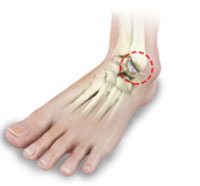
Coming soon
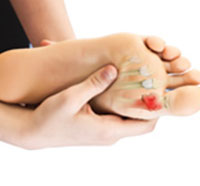
Sesamoiditis is an inflammation of the sesamoid bone and the associated tendons. It is commonly seen in ballet dancers, sprinters and basketball players. It is an overuse injury caused by an increased pressure over the sesamoid bones resulting in a chronic inflammation.
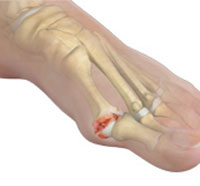
Hallux rigidus is an arthritic condition characterized by stiffness and rigidity of the big toe. Arthritis of the foot commonly occurs at the big toe base. The condition can be quite painful as the big toe has to bend with every step you take.
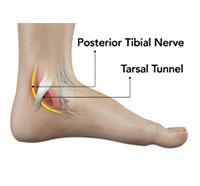
Tarsal tunnel is the gap that is formed between the underlying bones of the foot and the overlying tough fibrous tissue. Tarsal tunnel syndrome refers to a condition where the posterior tibial nerve that lies within the tarsal tunnel is compressed. The condition occurs when the tibial nerve is pinched.
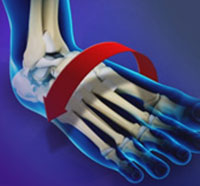
Ankle instability is a chronic condition characterized by a recurrent slipping off the outer side of the ankle. It usually results from repeated ankle sprains. It is generally noticed during movement of the ankle joint but can also occur during standing as well.

Coming soon

A bunion, also known as hallux valgus, is bony prominence at the base of the big toe, which often results in pain, redness and rubbing in footwear. The 1st metatarsal bone abnormally angles outward towards the other foot from its joint in the midfoot.

Achilles tendon is a strong fibrous cord present behind the ankle that connects the calf muscles to the heel bone. It is used when you walk, run and jump. The Achilles tendon ruptures most often in athletes participating in sports that involve running, pivoting and jumping.
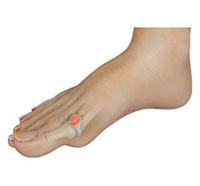
Cheilectomy is a procedure to remove excessive bone from the first metatarsophalangeal joint (MTPJ). The MPT joints are the junctions between the metatarsal bones (long bones in the foot) and the proximal bones (bone in toes).
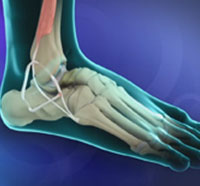
An ankle sprain is a common injury and occurs when you fall or suddenly twist the ankle joint or when you land your foot in an awkward position after a jump. It most commonly occurs when you participate in sports or when you jump or run on a surface that is irregular.
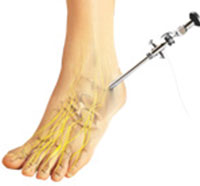
Ankle arthroscopy is a minimally invasive surgical procedure in which an arthroscope, a small, soft, flexible tube with a light and video camera at the end, is inserted into the ankle joint to evaluate and treat a variety of conditions.

Ankle fusion or arthrodesis is the surgical union of bones that forming the ankle joint. The ankle joint is formed by the tibia, talus, and the fibula bones. The goal of ankle arthrodesis is to relieve pain in the affected joint. This is achieved by surgically eliminating the joint.






